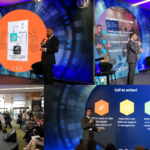The conversation about cognitive robots is more than just a trend; it’s a significant shift in our history. These robots are starting to show skills that resemble human thinking and creativity, leading us to wonder not just about their capabilities, but how they fit into our lives. With the massive amount of data we generate daily – over 2.5 quintillion bytes – cognitive robots have the potential to make sense of this information in ways that are meaningful and beneficial to us.
At the AI for Good Global Summit 2023, the session “4NE-1, a new era of human-machine collaboration with cognitive robots” held together with David Reger – the CEO and Founder of NEURA Robotics – explored the nuanced role of cognitive robotics in the digital era, emphasizing their potential as human allies rather than mere tools, and delving into the ethical and creative implications of their integration into society.
Navigating the creative crossroads
According to Reger, cognitive robots embody the fusion of AI with human creativity and insight. These advanced machines are not just about efficiency; they’re designed to perceive, understand, and interact with the world in ways that mirror human thought and intuition. By acting as allies rather than mere tools, these robots aim to increase human capabilities, opening new avenues for collaboration in lieu of replacing human roles.
However, the rapid evolution of AI presents a complex paradox, particularly in creative industries. Tools powered by AI, such as advanced image generators and sophisticated text-to-speech technologies, bring remarkable efficiency and cost-effectiveness. Yet, this technological boom also casts a shadow, challenging the traditional bastions of creativity like photography, design, and storytelling. The essence of the dilemma lies in AI’s potential to not just streamline creative tasks but to tread into the very heart of what it means to create, posing profound questions about the future of human ingenuity in the face of relentless automation.
“I do share the concern of the creative industries in particular because we see that many kinds of things we like, like storytellers or movie writers, are getting concerned and worried that they are not just creative minds but actually feeders of artificial intelligence,” said David Reger.
A leap in cognitive robotics
The 4NE-1 robot represents a significant milestone in the journey towards harmonious human-machine collaboration. Designed with advanced cognitive capabilities, 4NE-1 is more than just a machine; it’s a testament to the potential of AI to work hand-in-hand with humans.
Equipped with sensory inputs and a sophisticated processing unit, 4NE-1 can perceive its environment, make informed decisions, and execute tasks with a level of precision and adaptability that mirrors human interaction. This breakthrough in cognitive robotics not only showcases the technical prowess behind AI but also highlights the potential for these machines to become integral parts of our daily lives, assisting in tasks that range from the mundane to the complex.

Shaping a collaborative future
The ultimate aspiration of cognitive robotics extends beyond mere functionality. It revolves around crafting a harmonious coexistence between humans and machines, where technology empowers humanity to reach unprecedented heights of creativity and innovation. The overarching objective is not to create machines that dictate human actions but to foster the development of robotic helpers that significantly enhance our quality of life.
By equipping robots with the capability to understand, adapt to, and seamlessly interact with their surroundings, we lay the foundation for a symbiotic relationship. In this collaborative future, humans and machines join forces to achieve common goals. The significance lies in robots becoming integral partners rather than masters. The essence of this vision is to ensure that the advancements in AI and robotics serve as tools that augment human potential rather than diminish it.
“Talking about AI and cognitive robotics in combination, it will actually change the society in many areas of our lives. Let’s make sure together that we don’t let ourselves be downgraded to servants or AI feeders. Because we are the most creative and advanced species on the planet and I would like to leave it this way,” noted David Reger.
This session explored a new era in human-machine collaboration. This journey ahead is filled with both challenges and opportunities. By fostering a partnership between humans and cognitive robots, we can ensure that the advancements in AI and robotics revolve around a collaborative future where humans and machines coexist, mutually enriching each other’s capabilities. Together, we stride forward into a tomorrow where technology and humanity converge, opening doors to boundless creativity and innovation.
Watch our full video:
















